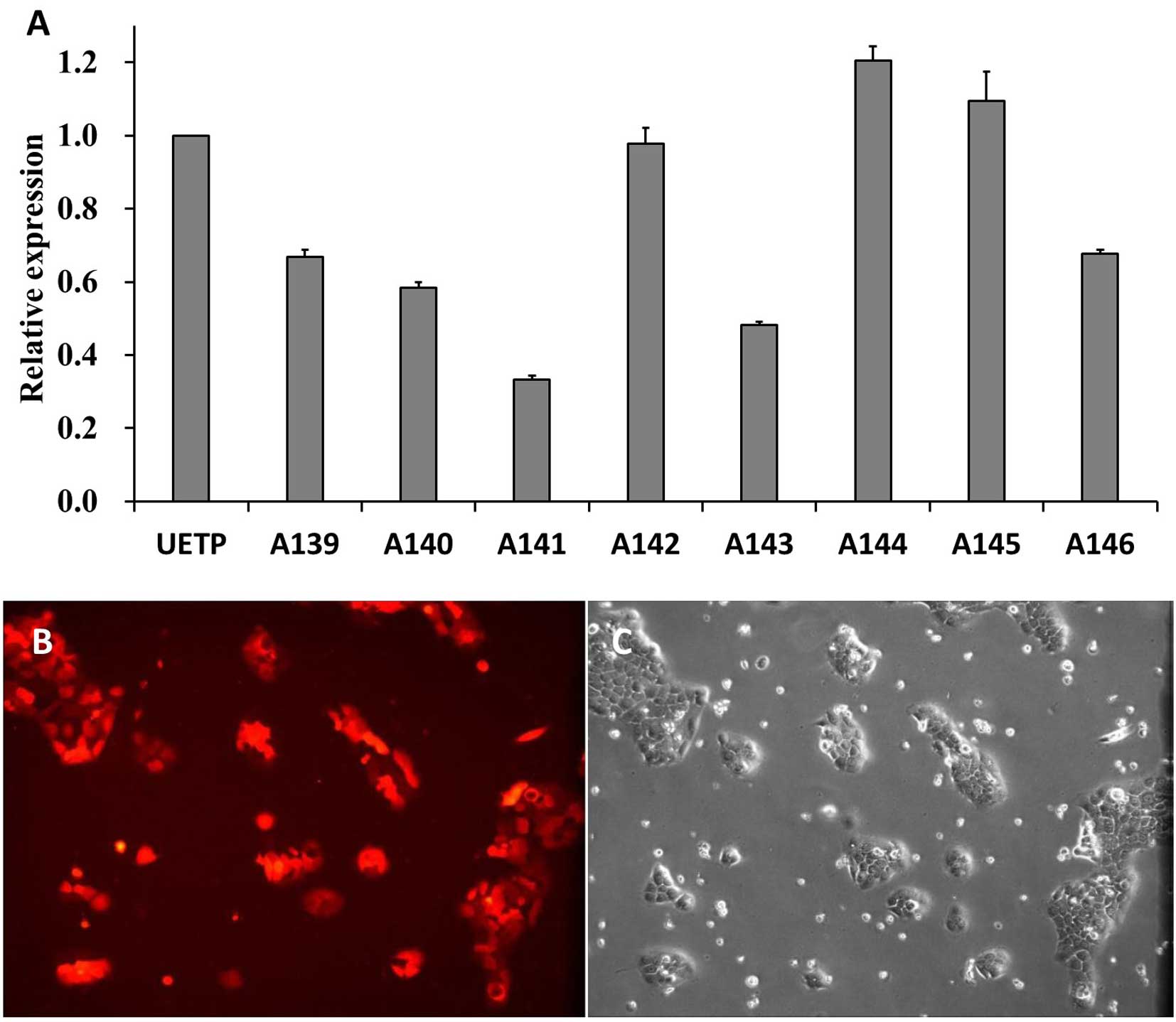|
1
|
Siegel R, Naishadham D and Jemal A: Cancer
statistics, 2012. CA Cancer J Clin. 62:10–29. 2012. View Article : Google Scholar : PubMed/NCBI
|
|
2
|
Frank TS, Sun X, Zhang Y, Yang J, Fisher
WE, Gingras MC and Li M: Genomic profiling guides the choice of
molecular targeted therapy of PC. Cancer Lett. 363:1–6. 2015.
View Article : Google Scholar : PubMed/NCBI
|
|
3
|
Rachagani S, Macha MA, Heimann N,
Seshacharyulu P, Haridas D, Chugh S and Batra SK: Clinical
implications of miRNAs in the pathogenesis, diagnosis and therapy
of PC. Adv Drug Deliv Rev. 81:16–33. 2015. View Article : Google Scholar : PubMed/NCBI
|
|
4
|
Matsuno S, Egawa S, Fukuyama S, Motoi F,
Sunamura M, Isaji S, Imaizumi T, Okada S, Kato H, Suda K, et al: PC
Registry in Japan: 20 years of experience. Pancreas. 28:219–230.
2004. View Article : Google Scholar : PubMed/NCBI
|
|
5
|
Sultana A, Smith C Tudur, Cunningham D,
Starling N, Neoptolemos JP and Ghaneh P: Meta-analyses of
chemotherapy for locally advanced and metastatic PC: Results of
secondary end points analyses. Br J Cancer. 99:6–13. 2008.
View Article : Google Scholar : PubMed/NCBI
|
|
6
|
Kufe DW: Mucins in cancer: Function,
prognosis and therapy. Nat Rev Cancer. 9:874–885. 2009. View Article : Google Scholar : PubMed/NCBI
|
|
7
|
Ponnusamy MP, Seshacharyulu P, Lakshmanan
I, Vaz AP, Chugh S and Batra SK: Emerging role of mucins in
epithelial to mesenchymal transition. Curr Cancer Drug Targets.
13:945–956. 2013. View Article : Google Scholar : PubMed/NCBI
|
|
8
|
Kaur S, Kumar S, Momi N, Sasson AR and
Batra SK: Mucins in PC and its microenvironment. Nat Rev
Gastroenterol Hepatol. 10:607–620. 2013. View Article : Google Scholar : PubMed/NCBI
|
|
9
|
Torres MP, Chakraborty S, Souchek J and
Batra SK: Mucin-based targeted PC therapy. Curr Pharm Des.
18:2472–2481. 2012. View Article : Google Scholar : PubMed/NCBI
|
|
10
|
Rachagani S, Torres MP, Kumar S, Haridas
D, Baine M, Macha MA, Kaur S, Ponnusamy MP, Dey P, Seshacharyulu P,
et al: Mucin (Muc) expression during PC progression in spontaneous
mouse model: Potential implications for diagnosis and therapy. J
Hematol Oncol. 5:682012. View Article : Google Scholar : PubMed/NCBI
|
|
11
|
Andrianifahanana M, Moniaux N, Schmied BM,
Ringel J, Friess H, Hollingsworth MA, Büchler MW, Aubert JP and
Batra SK: Mucin (MUC) gene expression in human pancreatic
adenocarcinoma and chronic pancreatitis: a potential role of MUC4
as a tumor marker of diagnostic significance. Clin Cancer Res.
7:4033–4040. 2001.PubMed/NCBI
|
|
12
|
Wu SC, Chen YJ, Lin YJ, Wu TH and Wang YM:
Development of a mucin4-targeting SPIO contrast agent for effective
detection of pancreatic tumor cells in vitro and in vivo. J Med
Chem. 56:9100–9109. 2013. View Article : Google Scholar : PubMed/NCBI
|
|
13
|
Jhala N, Jhala D, Vickers SM, Eltoum I,
Batra SK, Manne U, Eloubeidi M, Jones JJ and Grizzle WE: Biomarkers
in diagnosis of pancreatic carcinoma in fine-needle aspirates: A
translational research application. Am J Clin Pathol. 126:572–579.
2006. View Article : Google Scholar : PubMed/NCBI
|
|
14
|
Mimeault M, Johansson SL, Senapati S, Momi
N, Chakraborty S and Batra SK: MUC4 down-regulation reverses
chemoresistance of PC stem/progenitor cells and their progenies.
Cancer Lett. 295:69–84. 2010. View Article : Google Scholar : PubMed/NCBI
|
|
15
|
Ambesajir A, Kaushik A, Kaushik JJ and
Petros ST: RNA interference: A futuristic tool and its therapeutic
applications. Saudi J Biol Sci. 19:395–403. 2012. View Article : Google Scholar : PubMed/NCBI
|
|
16
|
Pecot CV, Calin GA, Coleman RL,
Lopez-Berestein G and Sood AK: RNA interference in the clinic:
Challenges and future directions. Nat Rev Cancer. 11:59–67. 2011.
View Article : Google Scholar : PubMed/NCBI
|
|
17
|
Agrawal N, Dasaradhi PV, Mohmmed A,
Malhotra P, Bhatnagar RK and Mukherjee SK: RNA interference:
Biology, mechanism, and applications. Microbiol Mol Biol Rev.
67:657–685. 2003. View Article : Google Scholar : PubMed/NCBI
|
|
18
|
Zhang C, Fu J, Wang Y, Bao Z and Zhao H:
Identification of suitable reference genes for gene expression
normalization in the quantitative real-time PCR analysis of sweet
osmanthus (Osmanthus fragrans Lour.). PLoS One. 10:e01363552015.
View Article : Google Scholar : PubMed/NCBI
|
|
19
|
Dijkstra JR, van Kempen LC, Nagtegaal ID
and Bustin SA: Critical appraisal of quantitative PCR results in
colorectal cancer research: Can we rely on published qPCR results?
Mol Oncol. 8:813–818. 2014. View Article : Google Scholar : PubMed/NCBI
|
|
20
|
Chaturvedi P, Singh AP, Moniaux N,
Senapati S, Chakraborty S, Meza JL and Batra SK: MUC4 mucin
potentiates pancreatic tumor cell proliferation, survival, and
invasive properties and interferes with its interaction to
extracellular matrix proteins. Mol Cancer Res. 5:309–320. 2007.
View Article : Google Scholar : PubMed/NCBI
|
|
21
|
Singh AP, Moniaux N, Chauhan SC, Meza JL
and Batra SK: Inhibition of MUC4 expression suppresses pancreatic
tumor cell growth and metastasis. Cancer Res. 64:622–630. 2004.
View Article : Google Scholar : PubMed/NCBI
|
|
22
|
Zhi X, Tao J, Xie K, Zhu Y, Li Z, Tang J,
Wang W, Xu H, Zhang J and Xu Z: MUC4-induced nuclear translocation
of β-catenin: A novel mechanism for growth, metastasis and
angiogenesis in PC. Cancer Lett. 346:104–113. 2014. View Article : Google Scholar : PubMed/NCBI
|
|
23
|
Rachagani S, Macha MA, Ponnusamy MP,
Haridas D, Kaur S, Jain M and Batra SK: MUC4 potentiates invasion
and metastasis of PC cells through stabilization of fibroblast
growth factor receptor 1. Carcinogenesis. 33:1953–1964. 2012.
View Article : Google Scholar : PubMed/NCBI
|
|
24
|
Lahdaoui F, Delpu Y, Vincent A, Renaud F,
Messager M, Duchêne B, Leteurtre E, Mariette C, Torrisani J,
Jonckheere N, et al: miR-219-1-3p is a negative regulator of the
mucin MUC4 expression and is a tumor suppressor in PC. Oncogene.
34:780–788. 2015. View Article : Google Scholar : PubMed/NCBI
|















